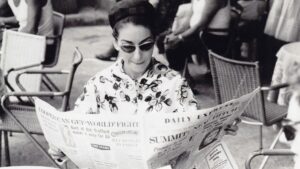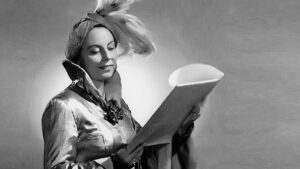
Christine Goerke’s Elektra has been with us for over a decade now, gracing the stages of a significant number of North American opera houses in that time (one exception being the Kennedy Center, where Elektra was last given in the 2007-2008 season with Susan Bullock and Goerke’s Chrysothemis).
Perhaps its most celebrated incarnation came not on the opera stage, but in her rapturously received 2015 concerts with the Boston Symphony, which set the tone for the steady string of appearances that have followed. Indeed, her dominance in the part on this side of the Atlantic has been so complete in recent years (save for Nina Stemme’s very notable visits in New York) that I fear audiences may have grown almost a bit complacent with so many chances to hear Elektra sung so well. But that would be a mistake.
As heard last Monday, the qualities that have made Goerke’s achievement in this role unique were in splendid evidence. Over the opera’s 100-odd minutes she unfurled Elektra’s punishing music in plush waves of sound, accessing a level of beauty and security in a role that has rarely been associated with either.
Where many singers must ration Elektra’s music, Goerke generously overwhelms you with it, cutting through the orchestral climaxes with thrilling volume while also delivering ravishing sweetness in the extended scenes with Orest and Chrysothemis.
While Goerke’s expansive middle register drove some of the most stunning singing here, she offers consistent strength across different facets of the role, from delicious low notes to a slightly more reserved but undeniably thrilling top.
Only in a select few of the most stratospheric passages did she become noticeably more cautious, drawing back a bit to prepare and relying on a faster vibrato that waded into less than beautiful territory, as in a few peaks of the opening “Allein” monologue. But these transitions were skillfully handled and ultimately only momentary diversions.
Goerke’s take on Elektra leans more to the sympathetic and naturalistic, which early on may come at the expense of some of the coldness and terror one expects out of the hoarier bits of “Allein” or the sparring with Klytamnestra.
But these choices are made in service of later payoffs, especially in the most personal material in the recognition scene, where she powerfully brings Elektra’s vulnerability to the fore, and in the unexpected emotional richness of Elektra’s joy in the final scene.
Sara Jakubiak brought a gleaming soprano to Chrysothemis, easily filling the opera house with the younger sister’s pealing lines and meshing beautifully with Goerke’s sound in their scenes together. Jakubiak brought an urgency to the portrayal, eschewing dreamy odes to fertility and marriage for firm declarations of her wants. Perhaps the only thing lacking was a bit more personal or distinctive edge in the vocal performance, which will hopefully deepen over time and make this a really unforgettable assumption.
Klytamnestra is a less traveled role so far in Katarina Dalayman’s second career as a mezzo. Though a bit underpowered to start she locked in quickly and brought a robust sound and musicality to the part. Her portrayal was more the dotty aging dowager than demented witch, consistent with the approach to the scene with Elektra here, which was frequently played for comedy.
I might not mind this in the context of a broader approach to the work, and Dalayman hit her beats effectively, but ultimately it felt like this potentially powerful scene had been under-played for unclear ends.
Bass-baritone Ryan Speedo Green is spending a lot of his time at the Kennedy Center this fall, appearing both here and as an unusually compelling Ferrando in Il trovatore on alternate nights. Green delivered a driven and terrifying Orest with a gripping pitch-black sound, evoking shades of Jochanaan in his divine purpose to avenge Agamemnon.
Elsewhere in the cast, Janacek veteran Stefan Margita brought an unusually pleasant tone to Aegisth’s short scene, while Alexandria Shiner made much of dual roles as the Fourth Maid and Trainbearer and Cecelia McKinley’s vibrant contralto stood out as Second Maid.
Since his appointment in 2018 as WNO’s principal conductor, Evan Rogister has had relatively few opportunities to make an impression due to the shutdown, and none in full length outings of the heavier German repertoire which makes up a significant portion of his conducting activities elsewhere.
His first foray into this territory for WNO happily delivered a propulsive and colorful reading of Strauss’ score, featuring both spine-tingling, percussion-forward climaxes as well as elastic pacing in quieter moments. A few rougher edges in some of the solos aside, the WNO Orchestra met Rogister’s demands with exciting abandon.Unfortunately, the high musical values were not reflected in the merely serviceable production, perhaps a sign of the post-pandemic times. WNO Artistic Directory Francesca Zambello handled the direction personally, but this was largely journeyman work. Earlier scenes like the confrontation with Klytmänestra tended to generic blocking that might have worked in any living room drama.
The recognition scene and final sequence were more effective, and Zambello organized a plausible final dance sequence for Elektra, but little of the shock and strangeness of the score came across in the staging. A notable though probably unnecessary bit of intervention came in the closing moments with some pantomime of Elektra figuring out what to do with the household staff, including some well-deserved vindication for that ride-or-die Fifth Maid.
The physical production, with a set designed by Erhard Rohm, is decidedly not the set designed for David McVicker’s early 2010s Elektra, which is featured on the posters and the front of the program. Rohm’s basic structure, a gray modernist space that can be reshaped through the use of different flies is the same seen on other nights in Il trovatore and previously did double duty for WNO several years back in rotating productions of Don Giovanni and Samson et Dalila(!) just before shutdown.
While a stretch for Trovatore’s parade of medieval locales, it was effectively redressed here as the palace courtyard through the use of additional set pieces and projections. Still, indeterminate lighting by Mark McCullough and a puzzling mix of not-very-expensive looking costumes designed by Biphu Mohapatra made it difficult to shake the sense that this was often a production of convenience.
Photos by Scott Suchman






Comments